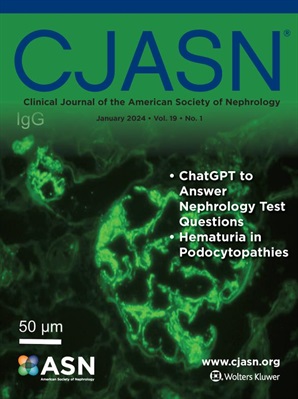揭示甲状腺和肾脏功能之间的因果关系:一个多变量孟德尔随机化。
IF 8.5
1区 医学
Q1 UROLOGY & NEPHROLOGY
Clinical Journal of the American Society of Nephrology
Pub Date : 2025-04-21
DOI:10.2215/cjn.0000000722
引用次数: 0
摘要
背景最近的研究表明,甲状腺功能障碍与肾功能之间存在关联,但其因果关系仍不确定。促甲状腺激素(TSH)、游离甲状腺素(fT4)和甲状腺过氧化物酶抗体(TPOAb)之间复杂的相互作用使这种联系的评估变得复杂。本研究采用多变量孟德尔随机分析法(MVMR)来阐明东亚和欧洲人群中甲状腺功能障碍与肾功能之间的因果关系。甲状腺功能通过测量 TSH、fT4 和 TPOAb 水平进行评估,甲状腺功能减退分为亚临床和显性两种。主要结果是以肌酐为基础的估计肾小球滤过率(eGFR),采用慢性肾脏病-肾脏病学协作方程计算。观察分析对年龄、性别、体重指数以及代谢和心血管因素进行了调整。MVMR分析使用与TSH、fT4和TPOAb水平相关的基因变异来评估它们对eGFR的因果效应。结果TSH和fT4水平均与eGFR成反比,甲状腺功能减退与eGFR降低相关。相反,TPOAb 与 eGFR 呈正相关。利用 26 个 TSH 遗传变异、4 个 fT4 遗传变异和 8 个 TPOAb 遗传变异进行的孟德尔随机分析证实,TSH 与 eGFR 之间存在因果关系。在各种 MVMR 方法中都观察到了 TSH 的显著因果效应(P 值从 0.05 起)。结论该研究发现,TSH 水平升高与肾功能减退存在因果关系,突出了甲状腺功能在肾脏健康中的潜在重要性。这些发现表明,在管理慢性肾病患者时应考虑甲状腺功能障碍。本文章由计算机程序翻译,如有差异,请以英文原文为准。
Unveiling the Causal Relationship Between Thyroid and Kidney Function: A Multivariable Mendelian Randomization.
BACKGROUND
Recent studies suggest an association between thyroid dysfunction and kidney function, but the causal relationship remains uncertain. The complex interactions between thyroid-stimulating hormone (TSH), free thyroxine (fT4), and thyroid peroxidase antibodies (TPOAb) complicate the assessment of this link. This study employed multivariable Mendelian randomization (MVMR) to elucidate the causal relationship between thyroid dysfunction and kidney function in East Asian and European populations.
METHODS
We conducted a cross-sectional study and MVMR analysis using data from 17,733 participants in the Taiwan Biobank. Thyroid function was assessed by measuring TSH, fT4 and TPOAb levels, with hypothyroidism classified as subclinical or overt. The primary outcome was creatinine-based estimated glomerular filtration rate (eGFR), calculated using the Chronic Kidney Disease-EPIdemiology Collaboration equation. Observational analyses were adjusted for age, sex, body mass index, and metabolic and cardiovascular factors. MVMR analyses used genetic variants associated with TSH, fT4, and TPOAb levels to assess their causal effects on eGFR. Data from the ThyroidOmics and CKDGen Consortium were used to replicate findings in European populations.
RESULTS
Both TSH and fT4 levels were inversely associated with eGFR, and hypothyroidism was correlated with lower eGFR. Conversely, TPOAb was positively associated with eGFR. Mendelian randomization analyses, using 26 genetic variants for TSH, four for fT4, and eight for TPOAb confirmed a causal relationship between TSH and eGFR. Significant causal effects of TSH were observed across various MVMR methods (P values from <0.001 to 0.01), whereas fT4 and TPOAb showed no significant causal effects (both P >0.05). These findings were consistent in European populations.
CONCLUSIONS
The study found that elevated TSH levels are causally associated with reduced kidney function, highlighting the potential importance of thyroid function in kidney health. These findings suggest that thyroid dysfunction should be considered in managing patients with chronic kidney disease.
求助全文
通过发布文献求助,成功后即可免费获取论文全文。
去求助
来源期刊
CiteScore
12.20
自引率
3.10%
发文量
514
审稿时长
3-6 weeks
期刊介绍:
The Clinical Journal of the American Society of Nephrology strives to establish itself as the foremost authority in communicating and influencing advances in clinical nephrology by (1) swiftly and effectively disseminating pivotal developments in clinical and translational research in nephrology, encompassing innovations in research methods and care delivery; (2) providing context for these advances in relation to future research directions and patient care; and (3) becoming a key voice on issues with potential implications for the clinical practice of nephrology, particularly within the United States. Original manuscript topics cover a range of areas, including Acid/Base and Electrolyte Disorders, Acute Kidney Injury and ICU Nephrology, Chronic Kidney Disease, Clinical Nephrology, Cystic Kidney Disease, Diabetes and the Kidney, Genetics, Geriatric and Palliative Nephrology, Glomerular and Tubulointerstitial Diseases, Hypertension, Maintenance Dialysis, Mineral Metabolism, Nephrolithiasis, and Transplantation.

 求助内容:
求助内容: 应助结果提醒方式:
应助结果提醒方式:


